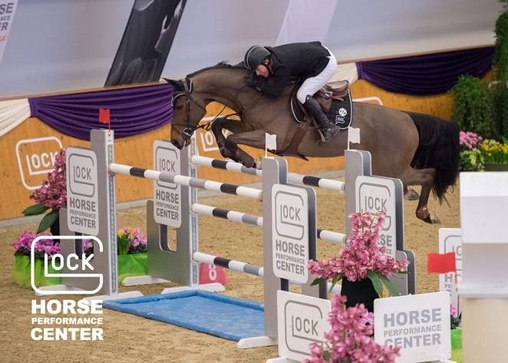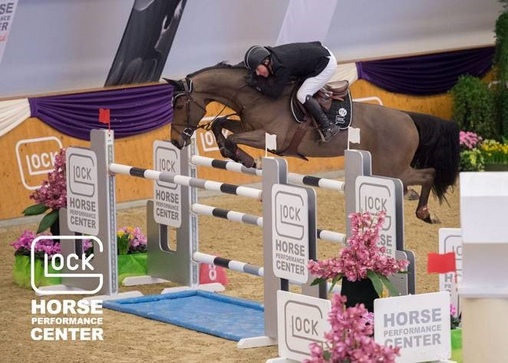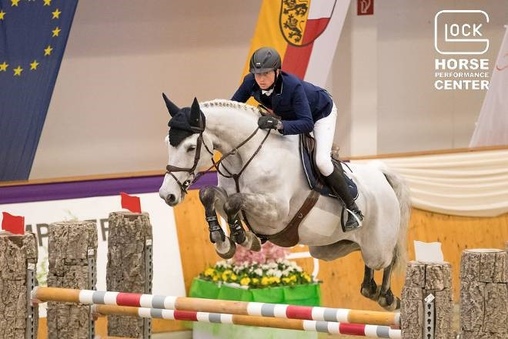 Friday, 11 January 2019 CSI5* CSI2* CSIYH1* 2019
Friday, 11 January 2019 CSI5* CSI2* CSIYH1* 2019Welcome to the 5-star premiere at GHPC Austria | The challenge round the course
For the first time ever, the GLOCK HORSE PERFORMANCE CENTER is opening the international tournament season in Austria with a 5-star equestrian sport event. Olympic champions, World and European Champions have already registered for the extravagant Season Opening at GHPC Austria from February 1st- 3rd 2019. For three days the riders and their horses focus on contesting victory and placings in twelve jumping competitions. The total prize money awaiting athletes at GHPC Austria amounts to 597,000 euros. Savour the excitement live as they take on the challenges of the many course layouts at GHPC Austria.
Oxer, upright, triple-bar and water jump
All around the world, fans will be thrilling to show jumping performed by athletes from a very wide range of nations and their four-legged mounts. Will that bar stay up, will that time do? For any spectator, show jumping is simple to comprehend and fascinates in a way that scarcely any other kind of equestrian sport can match. Whether in the hall, on small or large arenas, at national tournaments or even championships – witnessing the skill of riding the course is always a delight. But distributed along the way to the finishing line are many, altogether distinct hurdles. Together they make show jumping special.
Becoming a team
In order to learn to fly together, many top-riders train their horses themselves, with particular emphasis on sensitivity. A long journey must be made together. It involves daily practice of discipline, a carefully thought out training plan alongside fitness and wellness for both horses and riders. The horses must trust not only their riders but also themselves, they need to learn to master their own bodies and they are trained to the very peak of top athleticism. Only when a horse’s talent, capability and – from foal stage onwards - training are right, can that horse later emerge as a four-legged athlete to enter the most difficult courses in the world and, above all, prevail there consistently.
Challenges on the way to the show jumping finishing line
Differences relating to atmospheric conditions, size of the tournament arenas, ground conditions and type of travel always present new challenges for the horses and demand corresponding horse and travel management by participating teams. But the course obstacles also present a challenge over the course on account of the great variety in their design and appearance. They come in all forms, colours and particular builds and, particularly for championships, they’re both brightly coloured and substantial. The dimensions of the obstacles are laid out in the regulations according to class and various minimum and maximum sizes are allowed. For tournaments they can be up to 1.60 m high and have a spread of up to 2 m. Water jumps can be up to 4.50 m across. In individual cases – like a derby, puissance or six-bar – these dimensions may be substantially exceeded.
The most common obstacles
• The upright – consists of one rick and counts among the high jumps. On the course it may also appear as a wall, gate or fence.
• The oxer – consists of two ricks and is a combined high and long jump. With this obstacle, alongside its appearance and height, it is the spread above all that presents a challenge to both horse and rider.
• The triple-bar – usually consists of three ricks with ascending elements and is also a combined high and long jump.
• The water jump – is a long jump and may appear on the course as water with a structure above or as open water.
• In derbies there is also the Trakehner ditch (combined high and long jump), the bank (platform obstacle with jumps on and off) and the coffin, which is also a level-change obstacle.
Everything numbered
On the course, every obstacle has its own number, so that the rider knows how to progress from start to finish. Only combinations share an obstacle number, with the component obstacles featuring the number of the combination’s first jump and then the letters A, B and C. In show jumping, the term combination is used if only one or two canter steps lie between several jumps. A combination of two jumps is called a double combination, one of three jumps is a triple combination. However, if the horse has to jump immediately after landing between jumps, with no canter step between them, this is called an in-out.
Appearance, design, fitness
Competitors and their four-legged partners have many hurdles of appearance, design and fitness to overcome. It is important that the rider should be able to assess what his or her horse can take on, where to allow more or less space, whether to canter harder or back off and where the horse might perhaps be unsettled by the appearance of obstacles. Here the colours are less important than the type of construction of the obstacle. For example, white bars are harder for horses to focus on, or a wall can unsettle through being perceived as an opaque upright. The degree of difficulty of a show jumping tournament is determined by category and class. So it is that a jumping competition over 1.45 m in the context of a CSI2* tournament must present a significantly lower degree of difficulty than a jumping competition over the same height in a CSI5* event. But, in all cases, an ideal course matches the level, is good to ride both technically and in terms of appearance and thus also offers spectators great show jumping sport.
INFOBOX
What: International Show Jumping
When: 01–03/02/2019
Where: GLOCK HORSE PERFORMANCE CENTER Austria
VIP day tickets: call +43 664 88 73 44 01
Free entry to all competitive events
www.ghpc.at

With an enormous wealth of championship experience behind him is Dutch GLOCK Rider Gerco Schröder, here jumping an oxer over water in the saddle on GLOCK’s Dobelensky. © Nini Schäbel

It is on the world’s largest tournament arenas that Swiss championship rider Martin Fuchs feels at home. Here, in the saddle on Cool and Easy, he is flying with élan over a triple-bar. © Michael Rzepa
